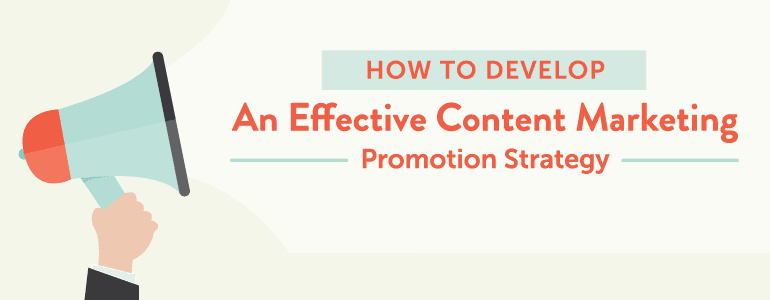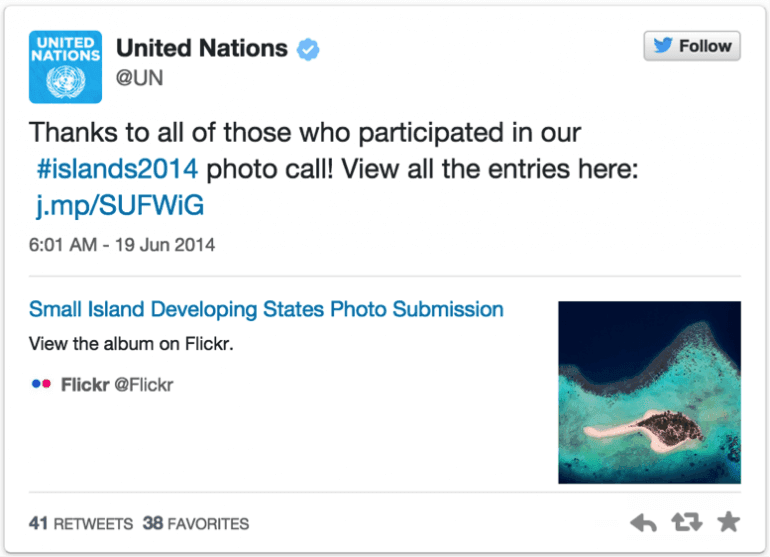How To Develop An Effective Content Marketing Promotion Strategy
 If you want the content marketing strategy for your business to be successful, you can’t rely on developing great content alone.
No matter what your content goals are, you need traffic to your content to achieve them. This is where effective content promotion comes into play.
In this post, we're going to look at five steps you can follow to promote each piece of content you create and get the best possible results from your content.
If you want the content marketing strategy for your business to be successful, you can’t rely on developing great content alone.
No matter what your content goals are, you need traffic to your content to achieve them. This is where effective content promotion comes into play.
In this post, we're going to look at five steps you can follow to promote each piece of content you create and get the best possible results from your content.
How To Develop An Effective #ContentMarketing Promotion Strategy @sujanpatel
Click To TweetStep 1: Optimize Your Content For Search
In the long run, if you optimize your content properly, search engines will likely be the best source of traffic for your content. You don't have to think about search engine optimization while you are creating your content. As a matter of fact, it's best if you don't think about SEO until after you have crafted a great piece of content with your visitors in mind.It's best if you don't think about #SEO until after you've crafted great #content. @sujanpatel
How to easily optimize your content for a keyword.
Once you have finished creating your content, you will want to optimize it for one keyword phrase. To do this, you can use Google's free AdWords Keyword Planner. Add a few keywords or keyword phrases that best represent your piece of content. Google's Keyword Planner can help you optimize your content so people looking for your stuff can actually find it.
Once you have found the best keyword phrase for your piece of content, you will want to make sure it is included in the title, meta description, first paragraph, last paragraph, and images.
Google's Keyword Planner can help you optimize your content so people looking for your stuff can actually find it.
Once you have found the best keyword phrase for your piece of content, you will want to make sure it is included in the title, meta description, first paragraph, last paragraph, and images.
As an example, let's look at this post. We started with "How To Develop an Effective Content Promotion Strategy" as the title. After using the Google AdWords Keyword Planner, we revised it to "How To Develop an Effective Content Marketing Promotion Strategy", which includes content marketing strategy, as that has a higher search volume. Note that while it's good to have all of the words for the keyword phrase you target together (such as content marketing strategy), it's not required. Those who don't search for content marketing strategy in quotes will get anything with those three words in the title in their search results.Here's an example of the top competition for the content marketing strategy keyword with a Google search engine results page. In addition to adding content marketing strategy to the title, we added it into the other areas mentioned, including the filenames of all of the images in the post. This optimization should help this post rank well for content marketing strategy in search engines.
Choose one keyword, use it in headings, titles, images, and first and last sentences. #SEO
Click To TweetStep 2: Optimize Your Content For Social Sharing
There are three ways to optimize your content for social sharing.
1. Offer social sharing buttons.
The first is to make sure that each page on your website has social sharing buttons. You can add them to your website's template files using the official code provided by networks like Facebook, Twitter, LinkedIn, and Pinterest. Or, for those using platforms such as WordPress, you can install plugins like Socialize or Flare.2. Use awesome images.
Next, you will want to have at least one great image per piece of content. When people share your content on social networks, most networks will pull a thumbnail image from your content to make it stand out in the news feed. If you don't add an image to your content, the shares of your content either won't have an image or will have an unrelated image from elsewhere on your website.3. Implement open graph tags.
Finally, you will want to implement open graph tags for your content. Open graph tags allow you to customize the way that your content is shared on social networks like Twitter, Facebook, and Pinterest.For example, this code for Twitter...You can find the code you need to implement open graph tags in the developer's support pages for Twitter Cards, Facebook Open Graph, and Pinterest Rich Pins. Or, for WordPress users, you can install plugins like JM Twitter Cards and Facebook for simpler open graph tag implementation....will allow tweets from the page it is implemented upon to look like this:
Step 3: Share Your Content With Your Social Media Audiences
Don't just leave it up to your visitors to share your content on social media.1. Promote your content on multiple social networks.
Your fans and followers connect with your social pages and profiles for a reason. Share your content with all of your social media audiences. It might sound like overkill at first, but keep in mind that you have different fans and followers on each network. If you just tweet your content, your Facebook and LinkedIn only audiences might miss it.If you only tweet your #content, Facebook and LinkedIn fans might miss it. @sujanpatel
Click To Tweet2. Promote your content at the best times.
In addition to having audiences who only pay attention to their newsfeeds on certain networks, you also might have audiences who are only online at certain times of day. Therefore, you might want to consider sharing your content at least twice on the day you publish it—once in the morning, and once in the afternoon or early evening. You can refer to this blog post from Neil Patel on the best time to publish and share content.Step 4: Share Your Content With Your Email List
To keep your email subscribers engaged with your list, consider sharing your latest pieces of content with them on a regular basis.1. Promote your content as it comes out or weekly.
You can do this using single emails focused on one piece of content or weekly emails compiling your best content. It's a great way to keep your business on your customers' minds without having to come up with a sale or promotion each time you send an email. A recent blog post email sent out to subscribers by Nicole, a community manager at When I Work.
A recent blog post email sent out to subscribers by Nicole, a community manager at When I Work.
2. Get a better understanding of your audience's interests.
An added bonus of sharing content with your email list is that it gives you insight into your subscriber’s interests. You can use this information to segment your list into groups based on the sales and promotions they would be most interested in receiving.For example, an e-commerce store that sells outdoor supplies can regularly send content to their list on various topics such as fishing, camping, and hunting. Then, when they have a sale on their fishing gear, they can send that promotional email to the subscribers who clicked on their latest content about fishing.
Step 5: Reach Out To Other Bloggers
Last, but not least, is outreach. There are many bloggers who love to share content created by others that is relevant to their audience.
1. Subscribe to related blogs.
Subscribe to top blogs in your industry and watch for topics similar to yours. When you see a post that could use a little more information that a piece of content you created can provide, email that blogger to let them know. This is something we do at When I Work, and something I do personally for every blog post I publish on my own site.2. Let other bloggers know when you've given them kudos.
Here’s an email I sent out to everyone mentioned in a recent post I published titled Top 100 Content Marketing Posts of 2014: Sending emails to every single person I mentioned in my post took time, but it was worth it.
As a result of my efforts, I received 300+ shares directly from emailing people, and I also developed a handful of new guest posting relationships with people I previously had no connection to.
Sending emails to every single person I mentioned in my post took time, but it was worth it.
As a result of my efforts, I received 300+ shares directly from emailing people, and I also developed a handful of new guest posting relationships with people I previously had no connection to.



